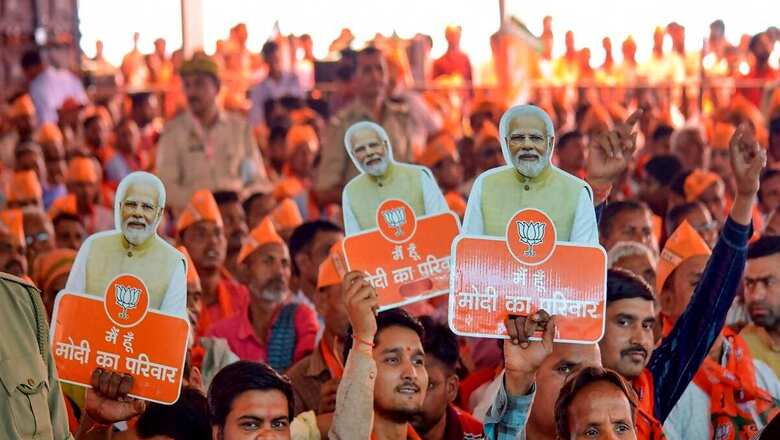
views
It is clearer than water that the incumbent ruling party, the BJP, is going to win the ongoing Indian general elections for the lower house of Parliament. The only question is by how many seats, votes and margin. Whether it will be able to tap the southern belt of India or gain a few in Kerala or West Bengal, we leave these questions to political pundits. In this article, we shall analyse how India will look after Prime Minister Modi and his cabinet take oath for the third term in a row.
Policies over Politics
If the BJP is able to surpass its 2019 mandate, it would mean that the party has made inroads in the SC/ST and even the Muslim community with a much better vote share. The BJP has always been dubbed as the Brahmin-Baniya and now, an OBC party, but after June 4, it will give tough competition to regional parties. Not only would the OBC vote bank have favoured the BJP, but the party will also give considerable representation to OBCs in the new Cabinet.
If the 2014 elections were about anti-incumbency of the UPA and ‘brand Modi’ and 2019 were all about the mass feeling of nationalism generated due to Balakot airstrikes, what about 2024? This election is being fought only on the delivery of policies by the NDA government. Policies over politics.
If Annamalai wins from Coimbatore along with 3-4 more seats from Tamil Nadu, the DMK and AIADMK need to worry about it. If Rajeev Chandrashekhar defeats Shashi Tharoor in Kerala, the BJP cadre in Kerala will get the much-needed motivation and ground support. If the party wins at least 2-3 seats from Punjab, it will be a signal that it doesn’t need Akali Dal anymore. If the BJP crosses 35 seats out of 48 in Maharashtra, it will pose a threat to the existence of Uddhav Thackeray and Sharad Pawar. If Rahul Gandhi loses from Raebareli, Owaisi loses from Hyderabad and Supriya Sule loses from Baramati, it will send jitters to the Opposition.
Jammu and Kashmir will again be a test match for the BJP as we anticipate its maiden elections this year. Article 370, counter-terrorism and tussle with regional parties will be worth witnessing.
Thus, the BJP getting 350 seats on its own will be a golden opportunity for the party to improve its organisational strength in south India, West Bengal and Maharashtra.
Unity in majority?
Throughout the election campaign, PM Modi and the BJP tried to de-emphasise caste as a factor in the elections, aligning with the party’s and the RSS’s broader goals. The Opposition, on the other hand, advocated for a caste census, arguing that it would reveal and address existing inequalities. The BJP countered that such a census would further fragment society into sub-groups, potentially increasing social divisions. Therefore, the NDA winning the 2024 elections with a huge majority indicates a step towards Hindu unity, with caste divides slowly and steadily being resolved.
The majority will further empower the NDA government to take up crucial issues challenging the Indian society like conversions happening in Punjab and Kerala. Unity in majority.
Modinomics
Amidst global headwinds and despite geopolitical tensions stemming from the Russia-Ukraine war and the Red Sea crisis, the Indian economy continues to experience rapid growth. It is not just India’s moment but India’s decade. Our GDP growth rate is averaged at 7.5 per cent by major global financial institutions. Racing to become the world’s third-largest economy, we are already at the fifth position. From stable forex reserves and slow but gradual ‘de-dollarisation’, there is a hope that our currency’s value will increase. Additionally, a few countries have agreed to trade with us in our very own rupee.
India continues to be a favoured destination for FDI. We recently hit the magical milestone of $5 trillion market capitalisation. From doubling farmers’ income to promoting investments in India, many promises were made, and some are yet to be testified after June 4. We have seen a rise in startups, MSMEs, local companies and the development of industrial and IT/logistics parks across the country. The youth has been a large beneficiary of government schemes including Digital India. The National Creators Award acknowledges the bustling creator and influencer economy.
The RBI has been successful in delivering a huge dividend to the government, and the economic policies will continue to be shaped as they are now. Not only Indians but we also have seen foreign diplomats using UPI and promoting it thereafter. Modinomics over traditional economics.
Cultural Renaissance
“Ayodhya toh abhi jhaaki hain, Kashi Mathura baaki hai”, a slogan which is age-old but saw its relevance in the 2024 elections. From the construction of the Shri Ram Mandir to Ujjain’s Mahakal Corridor and the increased emphasis on Sanskrit in the Indian education system, the Modi government has actively pursued a Hindu renaissance. This renaissance rests on three pillars: Sanatana (eternal tradition), Virasat (heritage), and Hindutva (Hindu identity).
After June 4, those in ‘Bharat’ can anticipate the potential abolition of the Waqf Act, which would pave the way for reclaiming Hindu temples destroyed by the Mughals. Furthermore, professional courses are likely to be offered in regional languages, following the model already implemented in Maharashtra and Uttar Pradesh. We are yet to see the play of the Uniform Civil Code at the Centre’s hands, but a trailer has been given by the Uttarakhand government.
If there is more to say, we shall not wish to kill curiosity. If there is less, we shall like to pretend we said it all.
Ritwik Mehta is a political strategist and Founder, Niti Tantra; Aditya Trivedi is a corporate lawyer and Founder, Arth Vidhi. The views expressed in this article are those of the author and do not represent the stand of this publication.

















Comments
0 comment